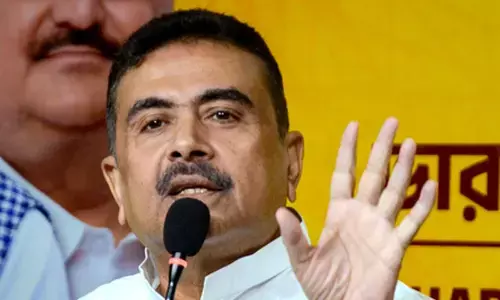Guns and goons in Woods

Guns And Goons In Woods. American movie makers have a penchant for everything that is out of this world. Alien invasion, for example, is one of the most preferred themes. Script writers have to create a weird enemy who can be vanquished in a maximum duration of 100 to 150 minutes on the screen.
Perceived threats from other countries is inherent to the American psyche and Hollywood dream merchants exploit it by going beyond the Earth, into the universe to find enemies of the US to portray them in all goriness and wickedness.
American movie makers have a penchant for everything that is out of this world. Alien invasion, for example, is one of the most preferred themes. Script writers have to create a weird enemy who can be vanquished in a maximum duration of 100 to 150 minutes on the screen.
The storyline, more or less, does not deviate from the core idea of extraterrestrial forces descending on some place in the US in mindboggling flying machines and trying to occupy the place; then how the special forces will be rushed in with their amazing weapons to battle the aliens who change their forms and shapes on the cue and unleash waves of terror. At the end, of course, Americans triumph and prove once again their invincibility even in the hands of imaginary creatures from distant planets.
For the audience around the world, including Indians, watching such Hollywood horrors on a big screen in stereophonic sound is a jaw-dropping experience. We know the films defy logic; make us fools; challenge our intellect; still they compel us to glue to our seats to watch them however incredulous they are. It’s entertainment, after all, Hollywood style. Panic, fear, mystery, suspense, action and a bit of melodrama go into the thriller in different proportions to make it a box office hit.

The most important element among the ingredients is full-throttle action with high decibel firepower, to raise adrenalin levels.
Perceived threats from other countries is inherent to the American psyche and Hollywood dream merchants exploit it by going beyond the Earth, into the universe to find enemies of the US to portray them in all goriness and wickedness. Violence will automatically become the film’s forte which will be packed with guns and a host of assorted weapons of various sizes.
Audience worldwide love to watch the boom-boom without realising how much does it impact on impressionable minds.
Violence in such films and others of that ilk that seem to glorify bloodletting has been a point of debate for decades in the US. Given the kind of rights and freedoms Americans enjoy, gun culture on and off the screen has become part of life; in some respects, it has taken deeper roots.
So, when President Barack Obama has turned to Hollywood in his crusade against gun culture in his country, urging the entertainment czars not to promote violence and glorify the usage of guns in their films as they may negatively influence the minds of children, he may be echoing the voice of millions of people. But can Hollywood give up its staple is the trillion-dollar question.
Addressing an event at DreamWorks studios in Los Angeles a few days ago, Obama said, "When it comes to issues like gun violence, we've got to make sure that we're not glorifying it because the stories you tell shape our children's outlook and their lives." Does he want Hollywood to go the way Bollywood of the 1960s and the 70s had gone offering cine-goers sweet and sour stories with song and dance? Even the Mumbai film industry has stopped producing fairy tale movies en masse. Now what comes out of its boxes is an eclectic mix of bare and dare.
But here too, guns, goons and girls have become inseparable from weaving the plot. Whether the story demands it or not the three elements are essential to ring in success at the till. In fact, all our regional cinemas from Bollywood to Tollywood, and every other Wood, inject extra doses of brutality and violence into their films for so-called mass appeal.
Censor Board officials do snip off violent and vulgar scenes, but their base bar level seems to have gone up and film producers may even seek ‘A’ certification instead of ‘U’ to woo viewers. But the point is whether graphic details of torture, gruesome murders and violence are needed to convey the intensity of enmity between two individuals or groups.
Here, the Indian cinema goes to extreme lengths than its counterpart Hollywood which will execute it in less than a minute. Killing is gory, not glory, but depicting it as the only solution to solve problems, personal or societal, is like choosing a path of violence even without exploring others. That is the subtle message films of such genre carries and leaves lasting impressions on the young minds.
India may not have as many guns in people’s hands as Americans have. Nor the young carry them to schools like toys and turn them on fellow students and teachers. But over the years, both street killings and the possession of fire arms, licensed and illegal, by private individuals has been increasing and there were instances when irascible people turned their guns on their opponents on the spur of the moment.
Films may not be the provocateurs for such actions; but they can act as triggers on sub-conscious minds. Whether one likes to admit or not, violence has become part of life and the entertainment industry should not add its share to promote violence since cinema’s outreach and influence on the masses is indisputable.
Next Story














